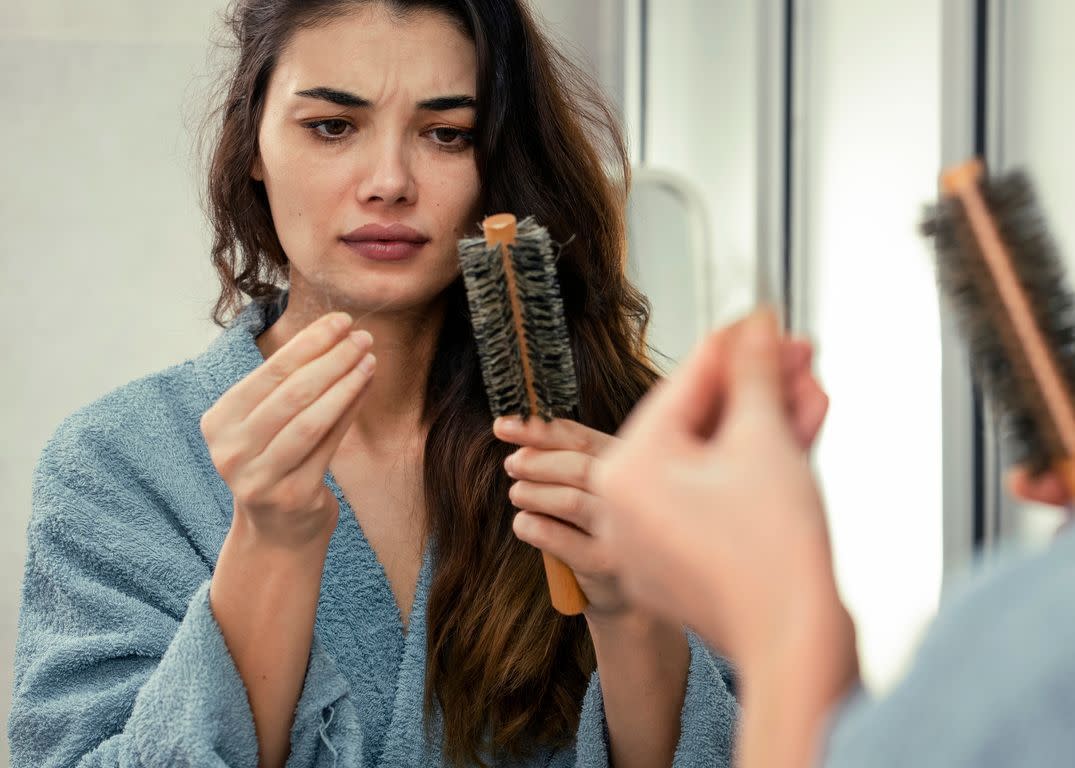Hair Loss in Women 101: Everything You Need to Know, From Symptoms to Treatment

It’s weird how growing up works. One day you’re trying to land that perfect first job and then suddenly you find yourself buying toilet paper in bulk and worrying about your hairline.
Listen, before you start swinging into a full-on tailspin, we’ve got the facts for everything you need to know about female hair loss.
From the root causes of female hair loss to treatments that can help regrow thinning hair, read on to learn how you can sport a full(er) mane again.
What Is Female Hair Loss?
First thing you need to know: hair loss doesn’t just affect dudes. Female hair loss is actually really common — a review of studies found that more than half of all females will experience hair thinning at some point in their lifetime.
The same review also showed the prevalence of hair loss increases with age — approximately 12 percent of women aged 20 and 29 years experience hair loss, while over 50 percent of women over the age of 80 do.
If you’re noticing a wider part, patchy spots or overall thinning and diffused hair loss over the scalp, you may be experiencing a type of female hair loss. Whether it may be a nutritional deficiency, a styling issue or plain ol’ genetics, we’ll dive into possible causes and treatments.
Causes of Hair Loss in Women
If you've been wondering “why am I losing so much hair?”, we have answers. Female hair loss can be caused by a variety of factors, from your genetics (thanks, Mom!), to your diet, to how much you’ve been stressing lately. To find the right course of action, it’s important to consider which of these may be affecting you.
We love this consultation quiz that helps you narrow down what might be going on, but the best bet? Talk to your healthcare provider or dermatologist to rule out any underlying medical conditions. Before that, we’ve got a little more reading that may help you narrow things down.
Hormonal Changes
You’ve probably heard a lot of buzz about balancing your hormones recently (hello, hormone balance coaches on TikTok). There’s truth to it — though our hormones play a massive role in your hair health.
In both men and women, the specific hormone believed to be responsible for genetic hair loss is the same: dihydrotestosterone (known as DHT), a hormone that your body produces as a byproduct of testosterone.
Just like how your genetics play a role in whether you have blue eyes or brown, they also play a role in how sensitive you may be to DHT. In some people, DHT can affect your hairline by attaching to hair follicles and causing them to shrink.
As these hair follicles get smaller, they can no longer support healthy hair growth, which contributes to hair loss. Basically, just like eating one too many Snickers, too much of anything is not good.
This type of hair loss caused by hormones is typically called androgenic alopecia (also known as androgenetic alopecia), or female-pattern hair loss (FPHL).
(Related: How to Prevent Hair Loss in Women)
Menopause
Sure, we’ve seen the movies where Diane Keaton is dealing with hot flashes. But hot flashes aren’t the only byproduct of menopause — it can also play a factor in hair loss.
When you go through menopause, your estrogen levels drop. This can potentially trigger hormonal hair loss in women. So if you’re 45+, and seeing marked decreases in overall hair density and diameter, this could be the reason.
Alongside this decline in female hormone production, your sensitivity to male hormones such as DHT (see above) can increase after menopause, which can cause hair loss. Learn more about factors that can cause hair loss in older women in this guide.
Thyroid & Autoimmune Issues
Feeling fatigued and experiencing weight fluctuations recently? Noticing hair thinning on top of it?
You may want to have your healthcare provider check your thyroid. Thyroid issues not only cause you to lose hair, but they can also cause your hair to become weak, dry and brittle.
But there’s a silver lining here — hair loss caused by thyroid issues is usually temporary. After you’ve identified and treated the underlying issue, your hair will slowly regrow to its previous thickness and length (hooray!).
Another potential cause of hair loss is an autoimmune disease called alopecia areata. This occurs when your immune system attacks your hair follicles, preventing the hair from growing.
These types of conditions don’t discriminate by age, so even young women are susceptible to these types of hair loss.
And if you think you may be dealing with an underlying medical issue, see your doctor to have them run necessary lab tests.
Stress
Spending all your energy in back-to-back draining meetings or dealing with a heartbreak? What about a recent drastic weight loss? These are all types of stressful events that can trigger hair loss.
Hair loss caused by stress is called telogen effluvium. This condition usually results in sudden thinning of your hair across your entire scalp, resulting in more hairs on your pillow, in the shower or on your hairbrush.
Like other forms of temporary hair loss, telogen effluvium affects your hairline by forcing hairs into the telogen phase, the final phase of your hair’s growth cycle. This can create the appearance of thinning, as new hairs aren’t coming in as fast as usual.
Like other non-hormonal forms of hair loss in women, stress-induced hair loss usually isn’t permanent. Through lifestyle changes and the use of medication, it’s usually possible to regrow most or all of the hair you’ve lost as a result of stress.
Styling
Love a tight slicked-back ponytail a la Ariana Grande? We do too. But if you’re constantly wearing styles that pull on the hair, you may notice signs of thinning. Be wary of styles that pull and cause stress on your hairline, causing traction alopecia. This type of hair loss is due to injuries, chronic or otherwise, to the scalp or hair follicle.
Hairstyles that can trigger traction alopecia include:
Buns, ponytails, and up-dos that are tightly pulled
Cornrows
Dreadlocks
Hair extensions or weaves
Tight braids
Symptoms of Hair Loss in Women
Now you know some common causes of hair loss in women, but if you’re still wondering if you’re dealing with normal hair shedding or actual hair loss, we got you.
You can learn more about female pattern hair loss in this guide, but here’s a quick drill on what signs of female hair loss can look like, according to the experts at the American Academy of Dermatology:
A wider part
Diffuse thinning across the scalp
A less dense ponytail
Bald spots
Receding hairline or frontal hair loss and breakage
Hair thinning along the temples and sides of your hair
Treatment Options for Hair Loss in Women
Once you’ve nailed down what the root cause of your hair loss is, you can consider your game plan to get back to Chia Pet status. Anyone else remember those? Here are the best hair loss treatments for women:
1. Minoxidil
Ah, minoxidil — she’s like the popular girl at school. Everyone knows her and a lot of people love her. Commonly sold under the brand name Rogaine®, minoxidil is a topical or oral medication that stimulates hair growth. It’s believed to work by encouraging your hairs to enter into the anagen stage, or growth phase, of the hair growth cycle.
Learn more about the efficacy of minoxidil in our guide on minoxidil for female hair loss.
While we aren’t saying it’s magic, there’s a lot of science to back up its efficacy. In a 2014 placebo-controlled trial, researchers found that both 2% and 5% versions of minoxidil improved hair thinning.
Hers offers a few different formulations of minoxidil that you can try:
5% foam
2% drops
Oral tablet, but note that this isn’t approved by the FDA for women and is prescribed off-label
Topical minoxidil and finasteride spray, which may be especially helpful for women experiencing hair loss after menopause
2. Spironolactone
This once-daily pill helps target hormones that cause excess hair shedding by decreasing testosterone levels in your blood and lessening its effect in your body. Healthcare providers now also prescribe spironolactone off-label to treat female pattern hair loss, or female androgenic alopecia. Taking spironolactone can be especially helpful for women with hormonal issues like polycystic ovary syndrome (PCOS).
3. Lifestyle changes
Remember when we talked about stress and its effect on female hair loss? Reducing stress — along with having a healthy diet, the right hair care and a balanced supplement intake — is also essential for healthy hair growth. If you need help handling stress, consider speaking with a therapist.
Eating a healthy diet is the best way to ensure you have all the vitamins and minerals you need for healthy hair, but you can also check with your doctor to rule out any nutritional deficiencies, like low iron. If necessary, they can recommend a supplement to help ensure a healthy body and head of hair.
(Related: PCOS Hair Loss: Why It Happens & How to Treat it)
The Final Word: Hair Loss in Women
Long story short, you’re not the only woman dealing with hair loss. While Drake may not want new friends, we totally welcome new hair. Here’s what you need to remember to get there.
It’s common. Nearly half of all women will experience hair loss at some point in their lives.
Spot the signs. If you’re noticing symptoms like a wider part, bald patches or a thinner ponytail, it’s time to take action.
Consider the factors. Think of what’s been going on in your life. Have you been dealing with a sudden illness? It could be stress-related hair loss. If you’ve been a lifelong fan of slicked-back ponytails, it may be a sign of traction alopecia. Figuring out the root cause will help you find the best treatment for your particular needs. Speak to a healthcare provider if you’re having trouble figuring out what’s going on.
Treat yo’self. Speaking of treatment options, take a cue from Tom Haverford and figure out a solution that works for you. There are many more options available for women's hair loss now than there were a few decades ago. With more science-backed research, you have really strong contenders to treat hair loss.
This article originally appeared on Forhers.com and was syndicated by MediaFeed.org
More from MediaFeed:
8 Smart Ways to Reduce the Price of Your Prescription Drugs

If you’re charging prescriptions to a credit card or digging for change in your car and couch every month to scrounge up enough money to pay for prescriptions, you’re not alone.
Around seven percent of U.S. adults can’t pay for prescription drugs they need, according to a 2021 Gallup poll. That’s an estimated 18 million people who say they had to go without at least one prescribed medication in the last three months, according to the poll.
If you struggle to pay for your meds or even worse, go without necessary medications, here’s some good news. With a bit of research and a strategy for finding discounts, you can save on prescription drugs.
DepositPhotos
Drug discount cards have been saving consumers money on prescriptions for decades. If your insurance doesn’t cover a prescribed drug or you’re saddled with a high copay, check the price on these drug discount sites to see how much you can save.
- GoodRX
- Blink Health
- SingleCare
- WellRX
Not up to the research? Ask your pharmacist if they have information on how much you can save with certain prescription discount cards.
DepositPhotos.com
Just because you’ve filled your prescriptions at CVS for the last 10 years doesn’t mean that pharmacy is the only game in town. Check prices at other local pharmacies, including your grocery store. If you can save enough to make the switch worthwhile, dole out your prescriptions among more than one pharmacy.

Ask your doctor if the prescribed medication has a generic version to save big bucks. “Generic drugs have exactly the same active ingredients and effects as brand-name drugs, but they can cost 30 percent to 80 percent less,” according to the Food & Drug Administration.
BCFC / istockphoto
Ordering a 90-day vs. a 30-day supply may save money on certain drugs. Check prices for both quantities before you fill a prescription. You’ll pay more upfront but the savings over three months may be worth it.
DepositPhotos.com
Check with local pharmacies for any discount programs they offer. For example, when you pay $20 (or $35 for a family plan) to join Walgreens’ Prescription Savings Club, you can get discounts on more than 8,000 medications. Plus, you can fill 90-day prescriptions on select generic drugs for the price you’d pay for two 30-day prescriptions.
Bonus: Walgreens’ program also provides discounts on prescriptions for your pets.
DepositPhotos.com
Save money by comparing prices at online pharmacies that deliver prescription drugs right to your doorstep. You may save a lot by ordering online.
Plus, you’ll save on gas and time by not having to drive to the pharmacy and wait in line.

Many drug manufacturers offer patient assistance programs if you meet income eligibility requirements. Contact the manufacturer for that pricey drug to find out if you’re eligible for deep discounts on a medication. To get an idea of how patient assistance programs work, visit RxAssist, which lists a comprehensive directory of patient assistance programs.

It is important to choose your health insurance wisely. Brokers are trained professionals that can assist you in finding the best plans for your unique needs. If possible, find a broker that is familiar with plans in your area and that is certified to sell ACA plans.
“The least expensive plan is not always the best or the most cost-effective option. Sometimes, a silver or gold plan may cost you less due to lower copays on brand name prescriptions. For those on Medicare, always have a broker review your part D (drug) coverage annually. Even if your monthly premium is not set to increase, there is no way to know that your prescriptions are still covered the same way for the next year unless you do an analysis of this plan,” says Analisa Cleland, an insurance and financial advisor at Coto Insurance.
If you are on a Medicare Advantage plan, have a certified broker review your coverage annually to ensure that your plan is still a good fit for your individual needs.
This article originally appeared on Debt.com and was syndicated by MediaFeed.org.
depositphotos.com




